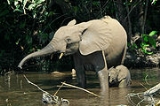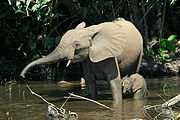
Wildlife of Rwanda
Encyclopedia

Flora
Flora is the plant life occurring in a particular region or time, generally the naturally occurring or indigenous—native plant life. The corresponding term for animals is fauna.-Etymology:...
and fauna
Fauna
Fauna or faunæ is all of the animal life of any particular region or time. The corresponding term for plants is flora.Zoologists and paleontologists use fauna to refer to a typical collection of animals found in a specific time or place, e.g. the "Sonoran Desert fauna" or the "Burgess shale fauna"...
. Rwanda
Rwanda
Rwanda or , officially the Republic of Rwanda , is a country in central and eastern Africa with a population of approximately 11.4 million . Rwanda is located a few degrees south of the Equator, and is bordered by Uganda, Tanzania, Burundi and the Democratic Republic of the Congo...
has 189 species of mammals and 729 species of birds.
Flora
The world's smallest water lilly, Nymphaea thermarumNymphaea thermarum
Nymphaea thermarum is the world's smallest water lily. The pads of N. thermarum measure only across, less than 10% the width of the next smallest species in the genus Nymphaea. By comparison, the largest water lily has pads that can reach...
, was endemic not only to Rwanda, but to the damp mud formed by the overflow of a freshwater hot spring in Mashyuza. It became extinct in the wild about 2008 when local farmers began using the spring for agriculture. The farmers cut off the flow of the spring, which dried up the tiny area—just a few square meters—that was the lily's entire habitat. Carlos Magdalena, at the Royal Botanic Gardens in Kew, manage to germinate some of the last 20 seeds, eight began to flourish and mature within weeks and in November 2009, the waterlilies flowered for the first time.

